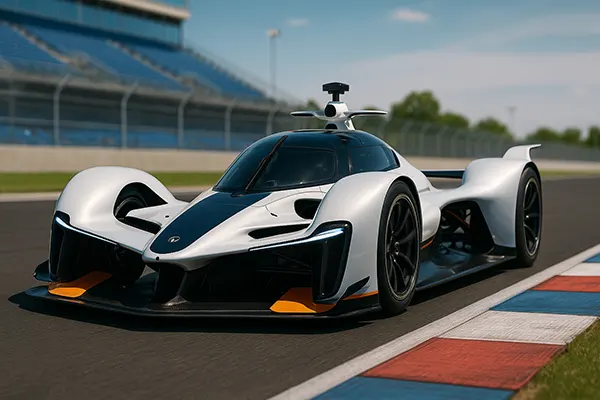
How Autonomous Racing Can Transform the Future of Motorsport
Autonomous racing has moved far beyond theoretical research and now plays an active role in shaping the broader direction of global motorsport. As of 2025, driverless racing projects such as Roborace, Indy Autonomous Challenge and various university-led competitions have demonstrated the capacity of AI-driven systems to perform safely at extreme speeds, react to unpredictable scenarios and generate data that influences both professional racing and consumer vehicle development. This field no longer exists on the sidelines; it forms a critical part of engineering progress that directly impacts car manufacturers, regulators and race organisers.
The Technological Value of Autonomous Racing
Advances achieved within autonomous racing deliver measurable benefits for motorsport teams and automotive companies. Sensors, real-time algorithms and vehicle-to-infrastructure communication tools developed for this environment are now used to improve safety models, simulation methods and decision-making systems in traditional racing. Engineers treat autonomous racing as a controlled yet demanding laboratory, where software can be pushed to the limits without the risk to human drivers.
Major championships increasingly rely on AI-assisted analytics to refine strategies, manage tyre performance and assess weather-related risks. Data captured by autonomous cars at speeds exceeding 300 km/h provides critical insights into braking behaviour, aerodynamic stability and track-surface changes. This information supports improved performance prediction models for motorsport teams that operate in highly competitive environments.
Furthermore, autonomous racing accelerates the integration of electric powertrains and energy-management technologies. Electric prototypes in these competitions rely heavily on AI to optimise battery usage, heat dispersion and regenerative braking. As a result, breakthroughs made in autonomous racing directly shape the next generation of sustainable performance vehicles.
The Role of Artificial Intelligence in Performance Development
Artificial intelligence serves as the central tool behind modern autonomous racing systems. Machine-learning models monitor thousands of variables simultaneously, adjusting steering, throttle and braking with precision that has become increasingly comparable to expert human drivers. Continuous training on simulated tracks allows these systems to adapt quickly to new surfaces, elevation changes or unexpected track events.
AI-driven decision mechanisms also introduce new methods of overtaking and risk assessment. Instead of relying on instinct, autonomous cars calculate probability-based scenarios, selecting manoeuvres with the highest likelihood of a successful pass while maintaining stability. This data-driven approach has already attracted the attention of professional racing teams seeking analytical tools that enhance driver coaching and race strategy.
In addition, AI contributes to mechanical development by analysing component stress in real time. Engineers apply these findings to build more robust suspension systems, lightweight materials and reliable braking components. Such improvements ultimately benefit both autonomous prototypes and traditional race cars.
Influence on Safety Standards Across Motorsport
The growth of autonomous racing has encouraged governing bodies to rethink safety frameworks. Without a driver inside the cockpit, teams can test scenarios that would otherwise be too dangerous, such as high-speed collision modelling or extreme weather performance. The data produced in these experiments helps redefine circuit design, trackside infrastructure and emergency-response procedures used throughout global motorsport.
Autonomous racing vehicles are equipped with multi-layered fail-safe systems that include redundant braking modules, additional sensor arrays and predictive avoidance software. These technologies serve as prototypes for new safety tools intended for professional drivers. By 2025, several championship organisers have already incorporated autonomous-derived algorithms into track-monitoring systems, enabling earlier detection of accidents or on-track debris.
Another significant contribution lies in the area of remote-control intervention. Race officials can override an autonomous vehicle in real time, stopping it immediately if a hazard is detected. Research into this field strengthens remote safety systems for traditional racing, supporting improved communication between race control and teams.
Testing Environments That Advance Global Motorsport Safety
Autonomous competitions offer closed testing environments where safety systems can be evaluated without compromising human wellbeing. This freedom allows engineers to push prototypes through extreme conditions, including sudden track-surface loss, multi-car avoidance situations and high-speed cornering instability. Results of these tests inform regulatory decisions across various motorsport categories.
High-precision equipment such as LiDAR, millimetre-wave radar and AI-enhanced cameras help identify performance thresholds that cannot be safely examined in traditional racing. These studies contribute to updated crash-structure standards and improvements in trackside barrier materials. Such findings become essential elements of engineering guidelines adopted internationally.
In addition, autonomous racing enhances the reliability of real-time telemetry systems used to support medical and technical response teams. Data aggregation during extreme events helps create more accurate intervention timelines and predictive risk models, strengthening safety oversight in professional motorsport.

How Autonomous Racing Shapes the Future of the Industry
Autonomous racing influences how manufacturers, leagues and sponsors plan long-term strategies. The development cycle for performance vehicles increasingly incorporates AI-assisted simulations modelled after autonomous racing data. These simulations reduce testing costs, shorten development timelines and enhance aerodynamic research.
The industry also sees a cultural transformation. Younger engineers and software developers now enter motorsport through robotics and AI fields, expanding the talent pool and adding new skills to the sport. Universities competing in autonomous challenges contribute significantly to innovation, often surpassing expectations with creative approaches to coding, vehicle control and sensor optimisation.
Finally, autonomous racing creates pathways for new competition formats. Hybrid races, featuring both human drivers and AI-controlled cars, are currently under evaluation for future seasons. These events aim to compare decision-making under equal conditions, encouraging debate about the role of technology in shaping competitive fairness and spectator engagement.
Long-Term Industry Outcomes Expected by 2030
Industry leaders predict that autonomous technologies will become standard in motorsport operations by 2030. Teams expect AI-supported tools to influence race preparation, mechanical diagnostics and aerodynamic modelling. The integration of autonomous systems will not replace drivers but will strengthen their performance through more advanced data.
Championship organisers plan to expand mixed-format events, allowing driverless prototypes to participate alongside electric racing categories. These competitions will help identify how autonomous vehicles behave in crowded racing environments, providing essential insights for future regulations.
Consumer vehicles will also benefit from the progress made within autonomous racing. Features such as advanced collision avoidance, improved sensor calibration and precise lane-keeping algorithms will be introduced more widely into production models. Motorsport will continue to function as the proving ground where these solutions mature before reaching the mass market.


